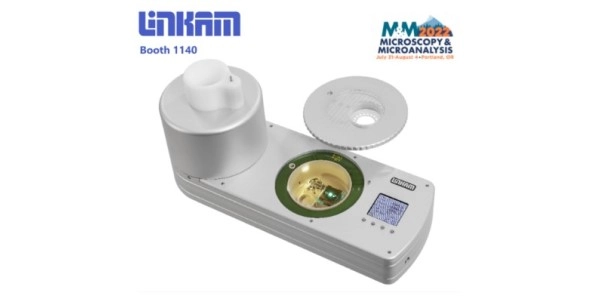
CryoGenium Is a New Development in Electron Microscopy Grid Vitrification
Linkam addresses several common issues that are found in a conventional plunge freezing setup
 Linkam previewed its new cryo plunger—CryoGenium—an exciting new
development in electron microscopy (EM) grid vitrification. Imaging of biological samples embedded in vitrified
ice has become of great interest in recent years as it provides several
advantages: the biological sample is in a fully hydrated state with superior
preservation down to ultra structural level, a vitrified sample is naturally
compatible with the vacuum required for EM/single particle (SPT)/correlative
light and electron microscopy (CLEM), and cryo fluorescence provides very low
photo-bleaching and high signal to noise imaging.
Linkam previewed its new cryo plunger—CryoGenium—an exciting new
development in electron microscopy (EM) grid vitrification. Imaging of biological samples embedded in vitrified
ice has become of great interest in recent years as it provides several
advantages: the biological sample is in a fully hydrated state with superior
preservation down to ultra structural level, a vitrified sample is naturally
compatible with the vacuum required for EM/single particle (SPT)/correlative
light and electron microscopy (CLEM), and cryo fluorescence provides very low
photo-bleaching and high signal to noise imaging.
Preparation and handling of vitrified samples normally requires special skills and techniques. The novel design of the Linkam CryoGenium makes this a simple and reproducible process.
CryoGenium addresses several common issues that are found in a conventional plunge freezing setup. Typically, the sample is prepared on an EM grid and excess liquid is removed inside a humidity chamber using blotting paper to control the ice thickness of the frozen sample.
The novel design replaces the common blotting mechanism to improve process stability and repeatability. The system introduces real-time optical observation of the sample with control of the liquid film thickness by adjusting the speed at which the sample is drawn from the fluid as well as thinning of the film thickness by controlled suction. The correct conditions for plunging can be confirmed by the real-time optical observation and plunging is followed by automated loading into either a special cryo-holder or a cryo-transfer container.
CryoGenium provides a platform that increases the success rate and quality of plunged grids, enabling improved efficiency and less time wasted at the transmission EM (TEM), resulting in cost savings.
The Linkam CMS196V3 Cryo-Correlative Stage provides another cryo correlative tool enabling the full workflow of CLEM to maximize efficiencies in the lab. Cryo-CLEM is a rapidly emerging technique that combines the advantages of fluorescence light microscopy (FLM) with three dimensional (3D) cryo-electron tomography (cryo-ET) to reveal the ultrastructure of target molecules with specific cellular functions. As well as maintaining the integrity of the sample vitrified by liquid nitrogen cooling, the Linkam CMS196V stage enables contamination-free sample handling and transfer for optical microscopy imaging.
The Linkam range of sample characterization tools, including the Modular Force Stage (MFS), has been specifically designed to gain a better understanding of a material’s behavior under different temperature, mechanical stress and environmental conditions. The systems offer advanced sensitivity, high resolution, and a modular concept for customized experiment design and control.
Duncan Stacey, sales and marketing director at Linkam, commented: “Materials science is an exciting, fast-paced field, and it is vital that we explore in depth the performance and potential of emerging new materials to unlock their positive impact on human life. As scientists seek new ways to tackle major global issues such as sustainable energy and bio engineering to improve human health care, we need to characterize and understand the physical properties of advanced materials. We were proud to present our latest products at this year’s Materials and Microanalysis, underlining our commitment to working in close partnership with our customers to develop the technology that suits the specific requirements of their business.”
To learn more about Linkam, please visit the website.










